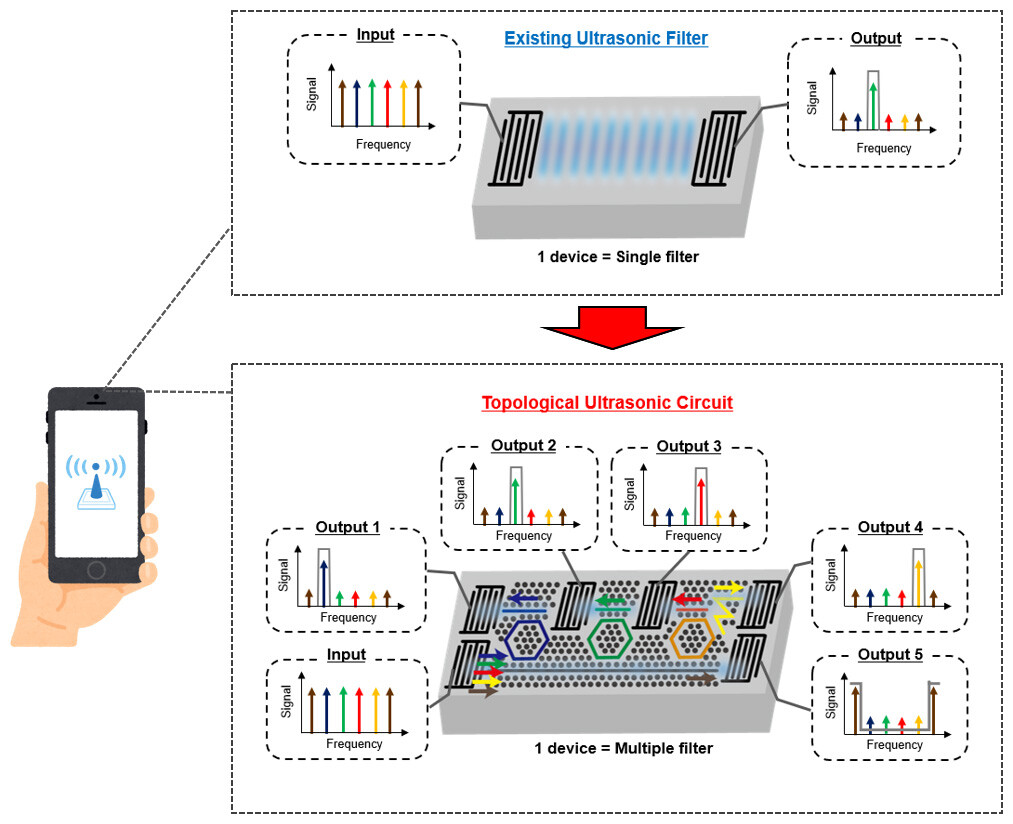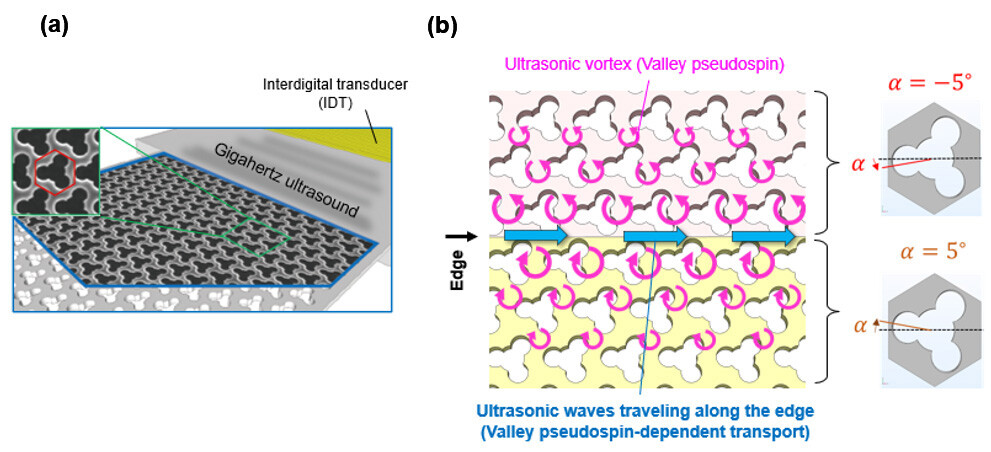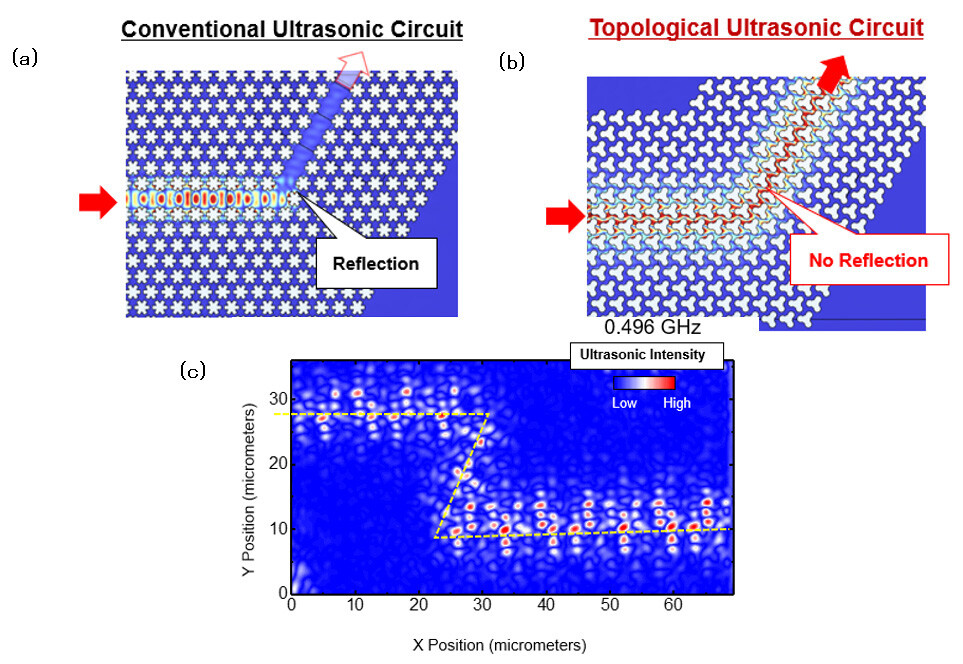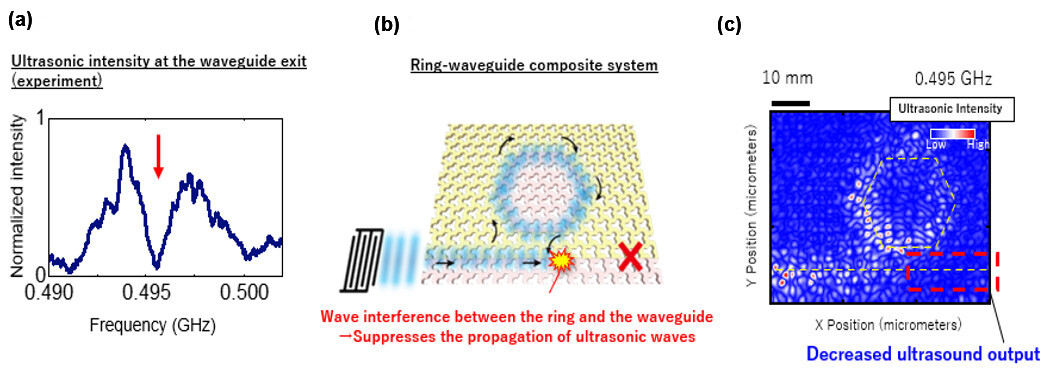Microsoft ends support for Internet Explorer on June 16, 2022.
We recommend using one of the browsers listed below.
- Microsoft Edge(Latest version)
- Mozilla Firefox(Latest version)
- Google Chrome(Latest version)
- Apple Safari(Latest version)
Please contact your browser provider for download and installation instructions.
July 22, 2024
NTT Corporation
Okayama University
First gigahertz ultrasonic circuit that uses the principle of topology
Realization of elemental technologies for miniaturization and higher performance of radio frequency filters for wireless communications
(This press release was published in Japanese on July 16, 2024.)
News Highlights:
- A special material called ultrasonic topological phononic crystal was developed using an artificial elastic structure consisting of periodic arrays of microscopic holes
- Using this structure, we succeeded in propagating ultrasonic waves stably without backscattering even on complicated and microscopic channels
- This result is expected to lead to miniaturized and high performance ultrasonic filters that support high-quality wireless communication for smartphones and IoT devices
TOKYO - July 22, 2024 - NTT Corporation (Headquarters: Chiyoda Ward, Tokyo; Representative Member of the Board and President: Akira Shimada; hereinafter "NTT") and Okayama University have developed the world's first gigahertz ultrasonic circuit utilizing the principle of topology. This technology makes it possible to freely control the flow of ultrasonic waves in microscopic spaces on semiconductor chips without reflections. It is expected to solve the problem of reflection in folded small waveguide structures, which was difficult with conventional technology, and lead to miniaturization and high performance of ultrasonic filters used in wireless communication devices such as smartphones and IoT devices.
This research result will be presented at META 2024, the 14th International Conference on Metamaterials, Photonic Crystals and Plasmonics, held in Toyama City, Toyama Prefecture from July 16-19, 2024.
1. Background
In recent years, wireless communication technology has been developing rapidly as it's led by 5G (5th generation mobile communication system), and realized an IoT society in which everything, including humans, home appliances and cars, are connected to the Internet and communicate with each other. To avoid interference from countless radio waves in space, a wireless communication device such as a smartphone must precisely extract and receive only the desired signal. Ultrasonic filters play an important role in this process. Ultrasound refers to waves in which matter vibrates at frequencies between kilohertz (kHz) and gigahertz (GHz). They possess much shorter waves than radio waves and have the excellent property that energy leakage is extremely small. This will realize filters that are much smaller and more energy-efficient than filters made from electronic components.
 Figure 1 Schematic diagram of an existing ultrasonic filter (top) and a topological ultrasonic circuit (bottom)
Figure 1 Schematic diagram of an existing ultrasonic filter (top) and a topological ultrasonic circuit (bottom)
Note. Existing ultrasonic filters have a single filter function per device. On the other hand, topological ultrasonic filter circuits can integrate multiple filters on a substrate, which makes it possible to realize multiple filter functions per device.
Wireless communication devices use various communication frequency bands depending on telecommunication methods such as Wi-Fi and Bluetooth, and country or region in which they are used. For example, high-end smartphones are said to contain nearly 100 ultrasonic filters, which allow them to efficiently send and receive signals in different bands. In a more advanced IoT society in the future, more and more filters will be required, and further miniaturization will be important. This requires an ultrasonic circuit that can confine vibrations in a narrow path (waveguide) and guide them in a desired direction, similar to an electric circuit. However, ultrasonic waves are difficult to bend, and sudden changes in direction can quickly cause backscattering, making it difficult to realize fine ultrasonic circuits.
NTT and Okayama University have newly applied topology1, a mathematical theory, to realize a topological ultrasonic circuit that can propagate gigahertz ultrasonic waves with reduced backscattering. Ultrasonic waves traveling through this circuit are protected by topological order2 created by the shape of the surrounding periodic holes and show stable propagation without reflection. Therefore, regardless of the shape of the waveguide, ultrasonic waves do not reflect and travel smoothly. Using this topological ultrasonic circuit, we succeeded in miniaturizing the size of an ultrasonic filter to hundreds of square micrometers, less than 1/100 of the size of a conventional ultrasonic filter, which is tens of thousands of square micrometers. These results are expected to enable the miniaturization, integration and multifunctionality of ultrasonic filters widely used in wireless communication terminals (Figure 1).
2. Outline of the experiment
The waveguide structure has two types of topological structures consisting of periodic holes tilted 5° counterclockwise or clockwise. When an external ultrasonic wave is applied to the edge of this structure, valley pseudospins3 are generated in both regions, which rotate in opposite directions, and ultrasonic wave propagation proceeds along the edge in one direction (Figure 2).
 Figure 2 Schematic diagrams of electron micrograph of fabricated device (a) and ultrasonic waveguide (b),
Figure 2 Schematic diagrams of electron micrograph of fabricated device (a) and ultrasonic waveguide (b),
Note. At the boundary (edge) between two regions with different pseudospin rotation directions (i.e., different topologies), there is no backscattering and stable propagation of ultrasonic waves. The internal holes are tilted 5° clockwise (yellow) and counterclockwise (pink).
This phenomenon is called valley pseudospin-dependent transport, and results in robust and stable traveling waves protected by topological order. As a result, even if there is a sharp bend, it does not reflect backward like normal ultrasound waves, but instead travels smoothly along the edge (Figure 3).
By utilizing this characteristic, we solved the problem of backscattering in the folded small waveguide structure, which was difficult with the conventional technology, and miniaturization and integration of ultrasonic devices became possible. We fabricated a ring-waveguide coupled structure that reduced the space required by conventional technology to less than 1/100 and demonstrated basic operation of a gigahertz ultrasonic filter (Figure 4).
This research was supported by the Japan Society for the Promotion of Science (JSPS) Grants-in-Aid for Scientific Research (S) "Development of Ultrasonic Topological Phononics for Multifunctional Elastic Wave Devices" (Project/Area Number: JP21H05020) and the Grant-in-Aid for Scientific Research (S) "Ultrahigh-speed magnophononic resonator devices" (Project/Area Number: JP23H05463).
 Figure 3 Numerically simulated spatial evolution of gigahertz ultrasonic waves propagating through a conventional ultrasonic circuit (a) and a topological ultrasonic circuit (b). In conventional circuits, the area where periodic holes are removed is a waveguide, and ultrasonic waves are strongly reflected at the corner bent 120° in the middle. In topological circuits, on the other hand, waves travel smoothly to the exit without backscattering. The periodic hole spacing, and the input ultrasonic frequency of both circuits are similar: 4 micrometers and 0.5 GHz, respectively.
Figure 3 Numerically simulated spatial evolution of gigahertz ultrasonic waves propagating through a conventional ultrasonic circuit (a) and a topological ultrasonic circuit (b). In conventional circuits, the area where periodic holes are removed is a waveguide, and ultrasonic waves are strongly reflected at the corner bent 120° in the middle. In topological circuits, on the other hand, waves travel smoothly to the exit without backscattering. The periodic hole spacing, and the input ultrasonic frequency of both circuits are similar: 4 micrometers and 0.5 GHz, respectively.
(c) Measurements of ultrasonic wave propagation through topological circuits shaped like the letter "Z." The dashed yellow lines indicate the edges.
 Figure 4 (a) Frequency response of the waveguide output in the topological ring-waveguide coupled system. There is a filtering effect around 0.495 GHz where the output drops significantly (red arrow). (b) Schematic diagram showing the principle of an ultrasonic filter. The ultrasonic waves circulate in the ring without backscattering, causing interference between the waves in the ring and the waveguide and suppressing the ultrasonic waves traveling through the waveguide. (c) Measured results of spatial propagation of ultrasonic waves at 0.495 GHz. Ultrasonic filtering significantly reduces the ultrasonic output in the waveguide.
Figure 4 (a) Frequency response of the waveguide output in the topological ring-waveguide coupled system. There is a filtering effect around 0.495 GHz where the output drops significantly (red arrow). (b) Schematic diagram showing the principle of an ultrasonic filter. The ultrasonic waves circulate in the ring without backscattering, causing interference between the waves in the ring and the waveguide and suppressing the ultrasonic waves traveling through the waveguide. (c) Measured results of spatial propagation of ultrasonic waves at 0.495 GHz. Ultrasonic filtering significantly reduces the ultrasonic output in the waveguide.
3. Key points of the technology
(1) Application of optimization design method for topological waveguide structures
Utilizing the know-how of Okayama University's acoustic topological structure design, NTT fabricated an ultrasonic circuit consisting of a two-dimensional periodic elastic structure in which holes with three-fold rotational symmetry are regularly arranged in a semiconductor thin film. The hole in the unit cell is a combination of four circular holes that can be easily reproduced by micromachining techniques. Furthermore, by simply rotating it counterclockwise or clockwise, an elastic structure with a different topology can be achieved. Okayama University and NTT used a numerical computation technique called finite element method4 to investigate the dispersion relation5 of ultrasonic waves for various rotation angles and calculated the optimal rotation angle (5°) at which topological order and waveguide formation are compatible. By using this optimization method, excellent topological circuits are constructed without repeating many trials.
(2) Utilization of valley pseudospin-dependent transport
The waveguide through which ultrasonic waves travel is made up of junctions (edges) sandwiched between clockwise (Figure 2, yellow) and counterclockwise (Figure 2, pink) regions with different topologies. The topological structure on both sides has ultrasonic vortices (valley pseudospins) rotating in opposite directions. As a result, ultrasonic waves that penetrate the edge are pushed out by vortices on both sides, and even if there is a bend or defect in the waveguide, they do not reflect backward, maintaining very robust and stable propagation. This characteristic that determines the direction of wave propagation depending on the direction of rotation of the ultrasonic vortex, which is the polarity of the valley pseudospin, is called valley pseudospin-dependent transport. It has a unique property (topological order) that the propagation of the waveguide edge is protected if the shape does not change significantly.
(3) Integration of topological ring and edge waveguide
The ring consists of a closed waveguide in a loop shape, and waves incident from another waveguide are amplified for only the components of a specific frequency and wavelength during the rotation in the ring. This composite structure can be used as a filter because the waves in the ring and the waveguide interfere to suppress the propagation of the waves at a specific frequency. In the case of gigahertz ultrasound, a large (low curvature) ring structure with a radius of 100 micrometers or more was conventionally required to avoid backscattering from the curved waveguide sidewalls. On the other hand, by introducing a topological structure, the influence of the backscattering is suppressed even in a structure with a large curvature, and a tiny ultrasonic ring with a radius of about 10 micrometers can be realized.
◆ Role of each institution
- NTT
NTT fabricated artificial elastic structures called phononic crystals by microfabrication of compound semiconductors such as gallium arsenide. NTT then examined how ultrasonic waves flow inside the structures by measuring changes in the reflected light of the irradiated laser. In addition, the propagation characteristics were numerically evaluated by the finite element method simulation. - Okayama University
In topology-based ultrasonic wave control, wave propagation characteristics are designed using artificial acoustic structures (phononic crystals). Okayama University has accumulated the know-how for phononic crystal design of various scales and has explored band dispersion and topological order in a wide spectral range from several hertz (Hz) to several terahertz (THz). (Reference DOI: 10.35848/1347-4065/acc6da)
4. Outlook
In this experiment, we established elemental technology for spatially controlling gigahertz ultrasonic waves. In the future, we will introduce magnetic materials and aim to develop technology that can dynamically control ultrasonic waves with an external magnetic field. If spatial and high-speed control of gigahertz ultrasonic waves becomes possible, it will enable ultrasonic waves to be used for not only filtering, but also high-frequency analog signal processing required for wireless communication devices such as frequency converters and amplifiers on the same chip. This eliminates the need for interdigital conversion and substrate connection between the ultrasonic filter and the electronic components used in the existing system and is expected to lead to further miniaturization of the antenna, and reduction in power consumption.
1Topology: The branch of mathematics that studies the shape of objects and the properties of space. It focuses on properties that do not change when the object is subjected to "continuous deformation" such as bending and stretching. In other words, topology focuses on how objects are connected, not their shape. For example, a doughnut and a coffee cup are considered the same. They're different shapes, but they're connected in the same way, so you can make a continuous transformation from a doughnut to a coffee cup or vice versa.
2Topological order: A new order of matter that introduces the idea of topology into physics. It is a state in which matter is not determined by symmetry disturbances, local defects, or fluctuations in physical variables, but by how the matter is connected. For example, when two materials with different topologies are connected, such as the topological ultrasonic waveguide in this experiment, the conduction state of the ultrasonic wave appears at the junction between different topology. The local order of the junction does not guarantee the existence of this state but by the nonlocal order of how the two topological structures that form the junctions are connected. This results in stable and robust ultrasonic wave propagation against structural fluctuations in the waveguide.
3Valley pseudospin: A quantum number that typically indicates that an electron or ultrasonic wave is in a particular valley (Valley is a specific region in phase space where the energy bands of electrons and ultrasonic waves dip like a valley). In this experiment, we define the state of ultrasonic waves in the valley. In the valley Hall topological structure, there are energy minima called valleys at K and K' points in momentum space. Ultrasonic waves traveling along the edge belong to either K or K' valley.
4Finite element method: A computational method that divides objects into small parts and analyzes their physical behavior. A tool that accurately simulates phenomena caused by complex geometries and actions.
5Dispersion relation: An equation that describes the properties of waves such as ultrasound and light. It mainly shows the relationship between wave frequency and wavelength.
About NTT
NTT contributes to a sustainable society through the power of innovation. We are a leading global technology company providing services to consumers and businesses as a mobile operator, infrastructure, networks, applications, and consulting provider. Our offerings include digital business consulting, managed application services, workplace and cloud solutions, data center and edge computing, all supported by our deep global industry expertise. We are over $97B in revenue and 330,000 employees, with $3.6B in annual R&D investments. Our operations span across 80+ countries and regions, allowing us to serve clients in over 190 of them. We serve over 75% of Fortune Global 100 companies, thousands of other enterprise and government clients and millions of consumers.
Media contacts
NTT Science and Core Technology Laboratory Group
Public Relations
nttrd-pr@ml.ntt.com
Okayama University
Public Relations Division, General Affairs & Planning Department
ww-adm@adm.okayama-u.ac.jp
Information is current as of the date of issue of the individual press release.
Please be advised that information may be outdated after that point.
NTT STORY
WEB media that thinks about the future with NTT









